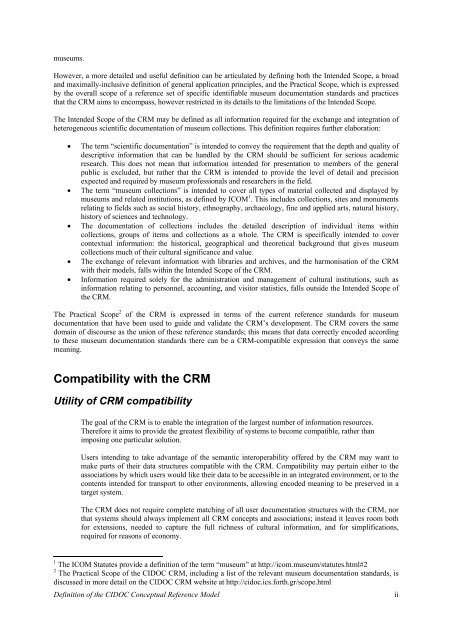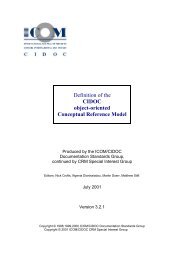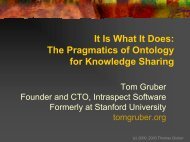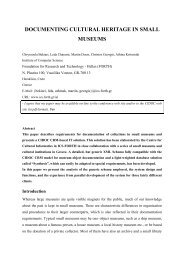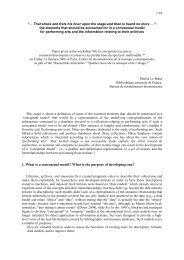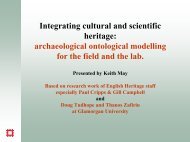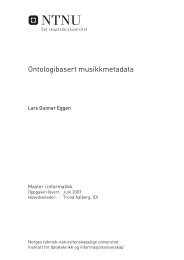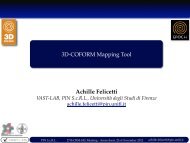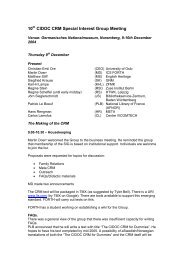pdf file - The CIDOC CRM
pdf file - The CIDOC CRM
pdf file - The CIDOC CRM
Create successful ePaper yourself
Turn your PDF publications into a flip-book with our unique Google optimized e-Paper software.
museums.<br />
However, a more detailed and useful definition can be articulated by defining both the Intended Scope, a broad<br />
and maximally-inclusive definition of general application principles, and the Practical Scope, which is expressed<br />
by the overall scope of a reference set of specific identifiable museum documentation standards and practices<br />
that the <strong>CRM</strong> aims to encompass, however restricted in its details to the limitations of the Intended Scope.<br />
<strong>The</strong> Intended Scope of the <strong>CRM</strong> may be defined as all information required for the exchange and integration of<br />
heterogeneous scientific documentation of museum collections. This definition requires further elaboration:<br />
• <strong>The</strong> term “scientific documentation” is intended to convey the requirement that the depth and quality of<br />
descriptive information that can be handled by the <strong>CRM</strong> should be sufficient for serious academic<br />
research. This does not mean that information intended for presentation to members of the general<br />
public is excluded, but rather that the <strong>CRM</strong> is intended to provide the level of detail and precision<br />
expected and required by museum professionals and researchers in the field.<br />
• <strong>The</strong> term “museum collections” is intended to cover all types of material collected and displayed by<br />
museums and related institutions, as defined by ICOM 1 . This includes collections, sites and monuments<br />
relating to fields such as social history, ethnography, archaeology, fine and applied arts, natural history,<br />
history of sciences and technology.<br />
• <strong>The</strong> documentation of collections includes the detailed description of individual items within<br />
collections, groups of items and collections as a whole. <strong>The</strong> <strong>CRM</strong> is specifically intended to cover<br />
contextual information: the historical, geographical and theoretical background that gives museum<br />
collections much of their cultural significance and value.<br />
• <strong>The</strong> exchange of relevant information with libraries and archives, and the harmonisation of the <strong>CRM</strong><br />
with their models, falls within the Intended Scope of the <strong>CRM</strong>.<br />
• Information required solely for the administration and management of cultural institutions, such as<br />
information relating to personnel, accounting, and visitor statistics, falls outside the Intended Scope of<br />
the <strong>CRM</strong>.<br />
<strong>The</strong> Practical Scope 2 of the <strong>CRM</strong> is expressed in terms of the current reference standards for museum<br />
documentation that have been used to guide and validate the <strong>CRM</strong>’s development. <strong>The</strong> <strong>CRM</strong> covers the same<br />
domain of discourse as the union of these reference standards; this means that data correctly encoded according<br />
to these museum documentation standards there can be a <strong>CRM</strong>-compatible expression that conveys the same<br />
meaning.<br />
Compatibility with the <strong>CRM</strong><br />
Utility of <strong>CRM</strong> compatibility<br />
<strong>The</strong> goal of the <strong>CRM</strong> is to enable the integration of the largest number of information resources.<br />
<strong>The</strong>refore it aims to provide the greatest flexibility of systems to become compatible, rather than<br />
imposing one particular solution.<br />
Users intending to take advantage of the semantic interoperability offered by the <strong>CRM</strong> may want to<br />
make parts of their data structures compatible with the <strong>CRM</strong>. Compatibility may pertain either to the<br />
associations by which users would like their data to be accessible in an integrated environment, or to the<br />
contents intended for transport to other environments, allowing encoded meaning to be preserved in a<br />
target system.<br />
<strong>The</strong> <strong>CRM</strong> does not require complete matching of all user documentation structures with the <strong>CRM</strong>, nor<br />
that systems should always implement all <strong>CRM</strong> concepts and associations; instead it leaves room both<br />
for extensions, needed to capture the full richness of cultural information, and for simplifications,<br />
required for reasons of economy.<br />
1 <strong>The</strong> ICOM Statutes provide a definition of the term “museum” at http://icom.museum/statutes.html#2<br />
2 <strong>The</strong> Practical Scope of the <strong>CIDOC</strong> <strong>CRM</strong>, including a list of the relevant museum documentation standards, is<br />
discussed in more detail on the <strong>CIDOC</strong> <strong>CRM</strong> website at http://cidoc.ics.forth.gr/scope.html<br />
Definition of the <strong>CIDOC</strong> Conceptual Reference Model<br />
ii


